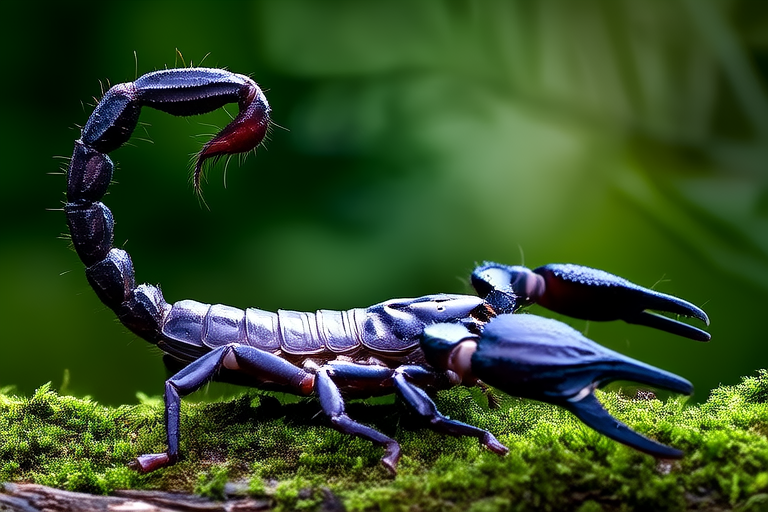From Jungle to Home: How to Care for Your Heterometrus spinifer Pet Scorpion
Welcome to the fascinating world of scorpions! Among the various species available as pets, the Heterometrus spinifer, commonly known as the Indian forest scorpion, stands out for its striking appearance and manageable size. This guide will walk you through everything you need to know about caring for your Heterometrus spinifer, ensuring both your safety and the well-being of your scorpion.
Habitat Setup
The first step in providing excellent care for your Heterometrus spinifer is setting up a suitable habitat. These scorpions come from tropical environments, so their enclosure should mimic these conditions.
- Enclosure Size: A tank that measures at least 10 gallons (approximately 38 liters) is ideal for one adult scorpion. The height of the tank is more important than the width, as they prefer vertical climbing spaces.
- Substrate: Use a substrate that allows for burrowing. A mix of coconut fiber and play sand works well, providing a natural environment for your scorpion.
- Hiding Places: Provide multiple hiding spots, such as cork bark, hollow logs, or artificial caves. Scorpions are nocturnal and require places to retreat during the day.
- Decorations: Include branches, rocks, and plants to create a stimulating environment. Be sure to secure decorations firmly to prevent accidental falls.
Temperature and Humidity Requirements
Maintaining the correct temperature and humidity levels is crucial for the health of your Heterometrus spinifer.
- Temperature: The ideal temperature range is between 75°F to 85°F (24°C to 29°C). Use a thermometer to monitor temperatures within the enclosure. Heat mats or under-tank heaters can be used to maintain consistent warmth.
- Humidity: Aim for a humidity level of around 70-80%. Mist the enclosure daily to achieve this, but ensure it dries out somewhat between mistings to prevent mold growth.
Diet Specifics
Your Heterometrus spinifer is an opportunistic feeder, meaning it will eat whatever prey is available. Here’s how to provide a balanced diet:
- Feeding Frequency: Feed adults once every two weeks. Juveniles may require feeding more frequently, approximately every week.
- Prey Options: Crickets, mealworms, and dubia roaches are all suitable. Occasionally, you can offer other insects like waxworms or superworms for variety.
- Supplements: Dust the prey with calcium powder to ensure proper bone development and dust with a multivitamin supplement once a month.
Handling Tips
While Heterometrus spinifer are generally docile, handling should be done with caution:
- Gloves: Always wear thick gloves when handling your scorpion. Even if they appear calm, their sting can still cause discomfort.
- Minimal Handling: Avoid frequent handling, as it can stress the scorpion. If you must handle it, gently scoop it up using a plastic container.
- Environment: Ensure the environment remains stable during handling. Sudden changes in temperature or lighting can cause stress.
Health Concerns
Understanding potential health issues can help you provide better care for your pet.
- Stress: Stress can lead to reduced appetite, lethargy, and increased susceptibility to illness. Minimizing handling and ensuring a stable environment helps mitigate this.
- Parasites: Scorpions can be susceptible to mites and other parasites. Regular inspection and quarantine of new prey items can help prevent infestations.
- Molting: Molting is a natural process where the scorpion sheds its exoskeleton. During this time, avoid disturbing the scorpion and ensure the humidity is high.
Common Behaviors
Observing your Heterometrus spinifer’s behavior can provide insight into its needs and overall health.
- Nocturnal Activity: As nocturnal creatures, your scorpion will be most active at night. Providing adequate hiding spots ensures it has a place to rest during the day.
- Defensive Behavior: When threatened, Heterometrus spinifer may lift their tail as a warning. This does not necessarily mean they are about to sting; it’s often a defensive posture.
- Feeding Behavior: Scorpions typically catch and kill their prey using their pincers before injecting venom. Watching them hunt can be an exciting part of owning this pet.
Scientific Facts About the Species
Learning about the biology of Heterometrus spinifer can deepen your appreciation for this unique creature.
- Size: Adults can grow up to 6 inches (15 cm) in length. They have a distinctive appearance with a brownish-green coloration and long, slender legs.
- Lifespan: In captivity, they can live for 6-8 years, sometimes longer with proper care.
- Venom: While their venom is not deadly to humans, it can cause pain similar to a bee sting. Always handle with care.
- Reproduction: Females carry their young on their backs for several weeks after birth. Captive breeding is rare but possible with experienced keepers.
Conclusion
Owning a Heterometrus spinifer can be a rewarding experience for those willing to learn and provide the right care. By understanding their natural habitat, dietary needs, and common behaviors, you can ensure your scorpion leads a healthy and happy life. Remember, patience and respect are key when interacting with these fascinating arachnids.
With the right setup and care, your Heterometrus spinifer will thrive in its new home. Enjoy the journey of learning and bonding with this unique pet!
